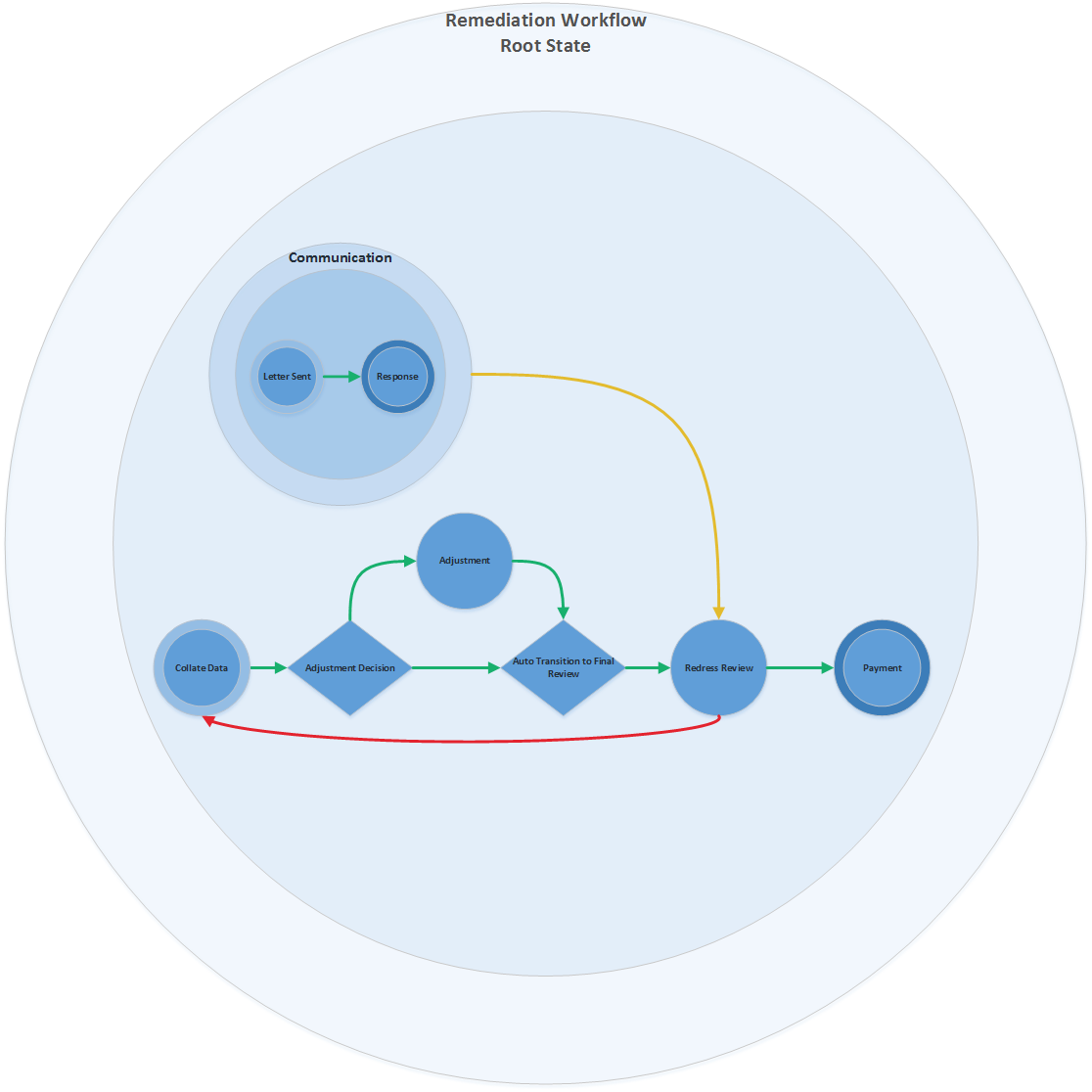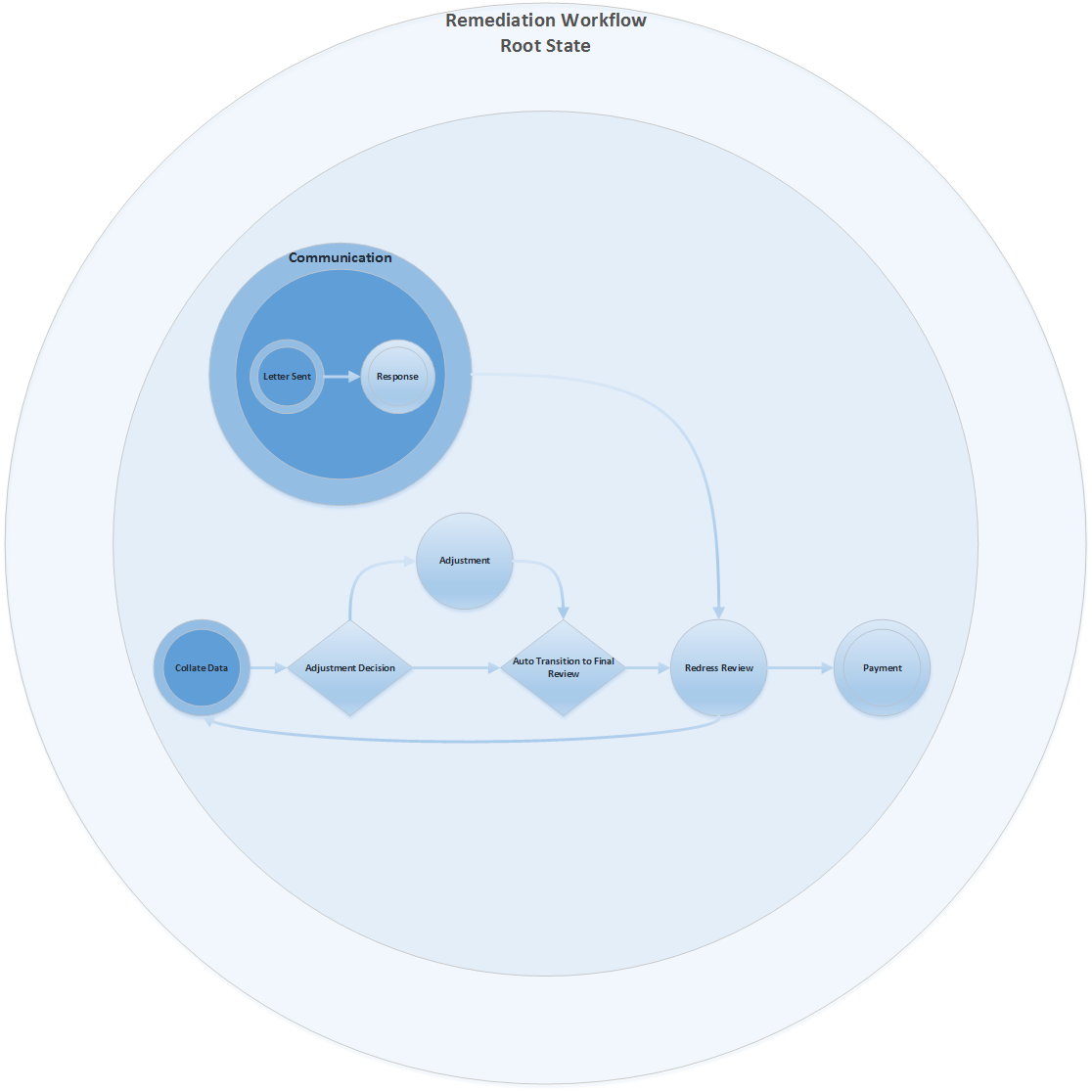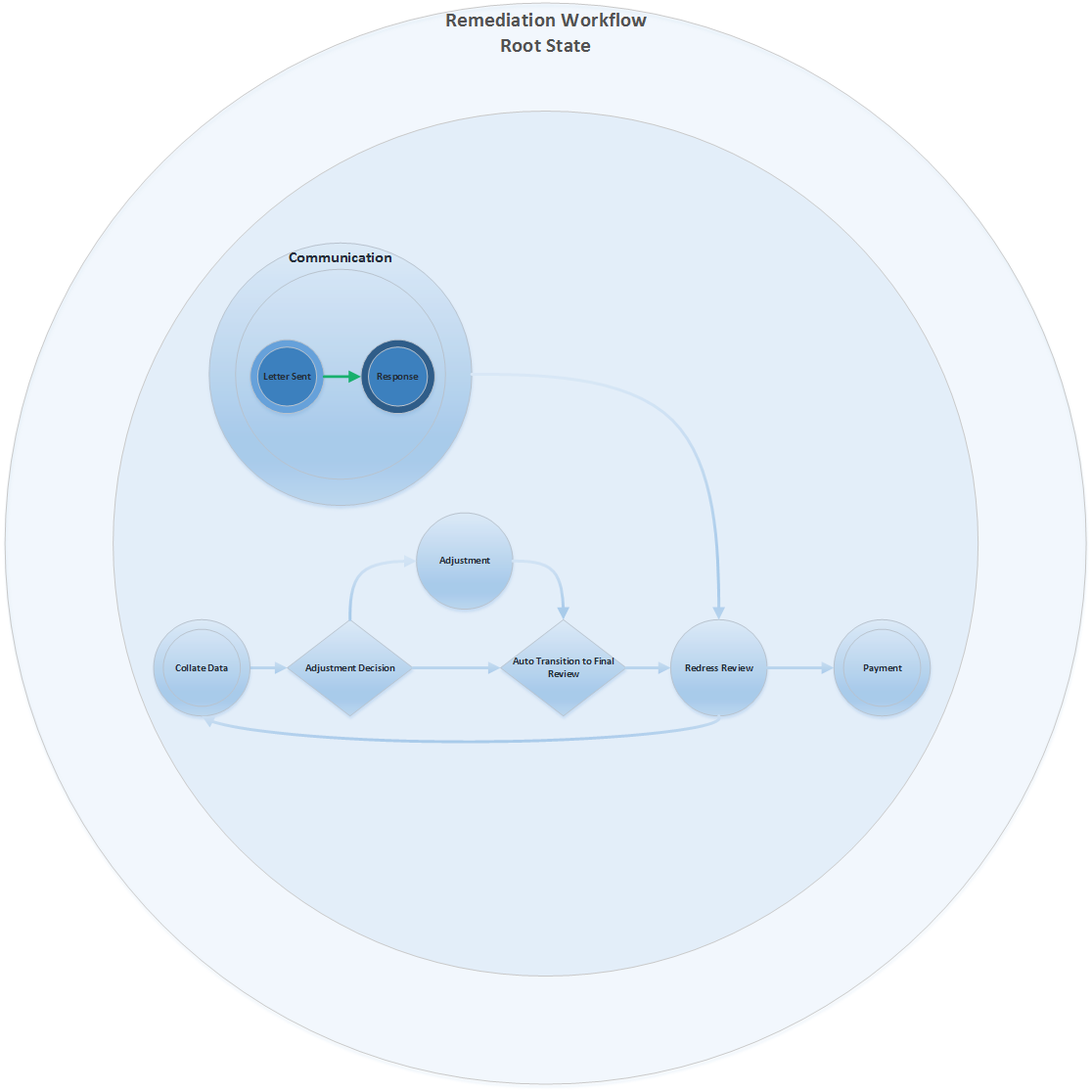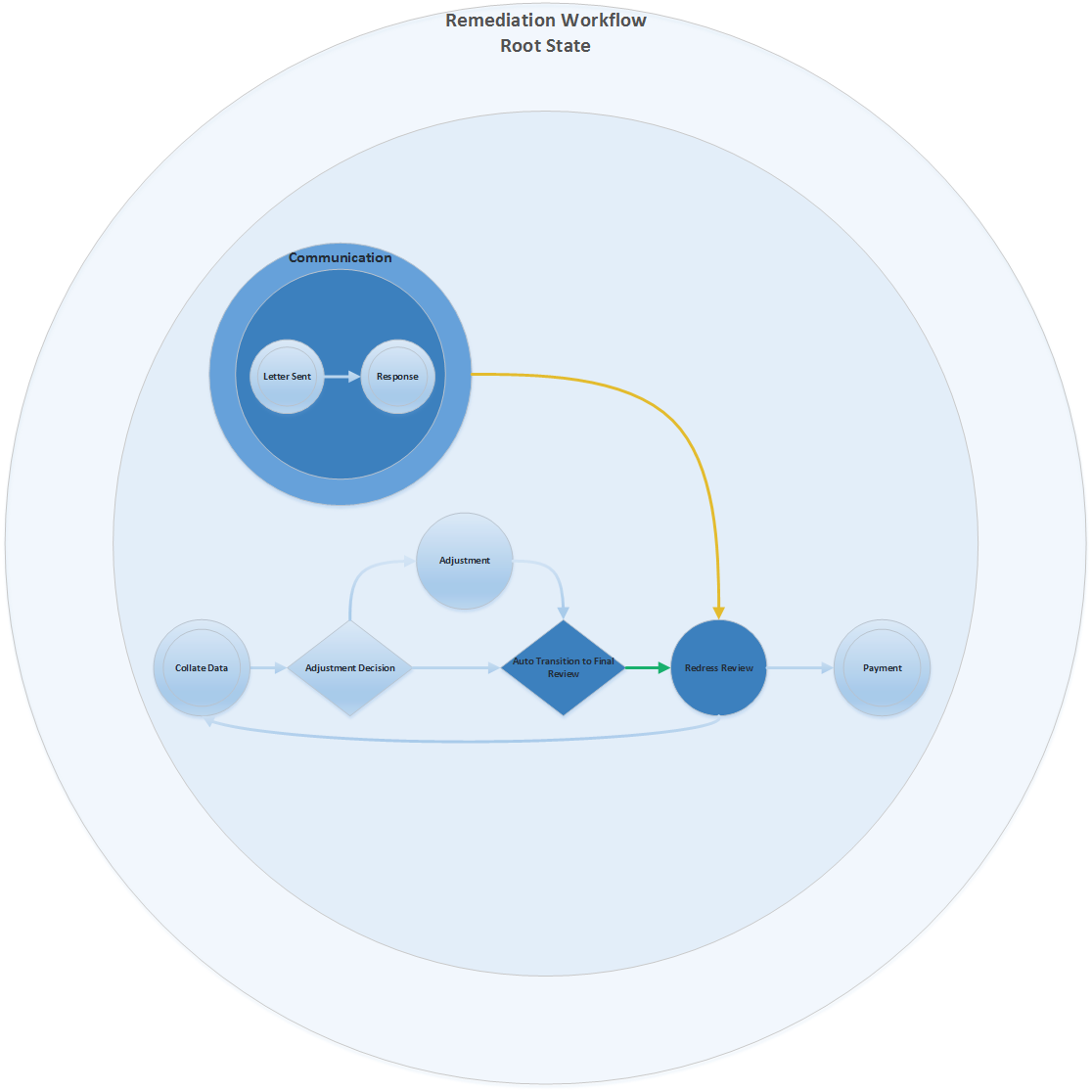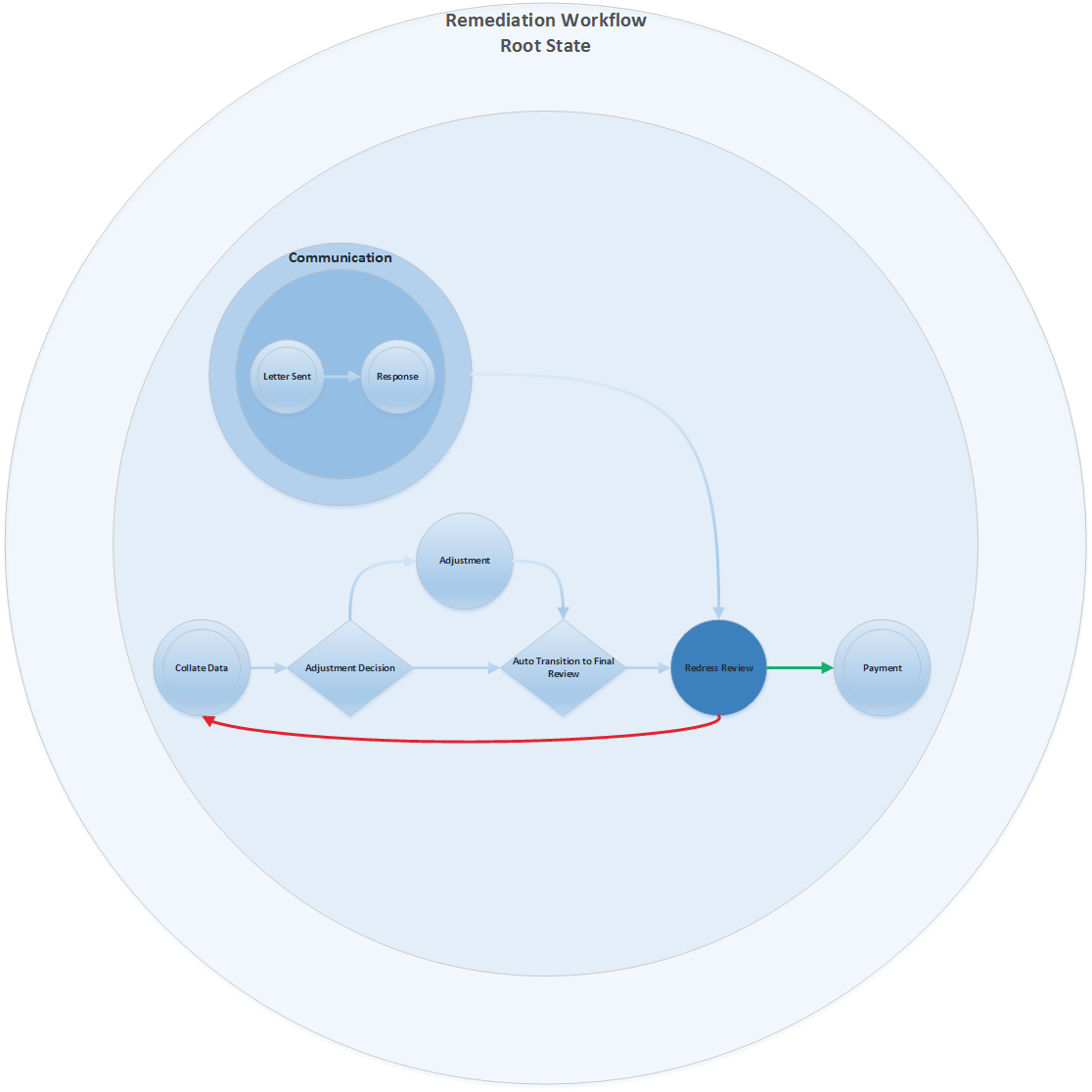Dipstate provides a simple mechanism to maintain state for an activity based workflow.
- Action delegates execute with context for entry, exit, reset and status changed events
- Conditional transitioning between states
- States can have sub-states
- Support for auto states
- Support for dependency states
- Id – the identifier of the state
- Name - the name of the state
- Status - the status of the state
- IsDirty - indicates whether the status of the state has changed
- InitialiseWithParent - indicates whether the state will be initialised when its parent is initialised
- CompletionRequired - indicates whether completion of the state is required in order for its parent to complete
- Context - the states context
- Type - the type of state
- Parent - the parent of the state
- Antecedent - the preceding state in a workflow from which the state was transitioned from
- Transition - the state to transition to
- Transitions - a list of states from which the state can transition to
- Dependencies - a list of dependency states that must be completed before the state can be initialised.
- Dependants - a list of states that are dependent on the state being completed before they can be initialised
- SubStates - a list of sub states. Sub states can behave as mini workflows under their parent
- Log - the state log
- Actions - a list of action delegates that are executed at different stages in the lifecycle of the state
- Root is a state that represents a workflow. Its sub states are the states within the workflow. Initialising the root state is the entry point into the workflow and is automatically completed when the last sub state requiring completion has completed.
- Auto is a state which will automatically complete itself after initialisation. Entry actions are executed during the initialisation which is a good place to perform some task or determine the state it needs to transition to at runtime..
- Standard is a plain vanilla state.
Creating different types of states:
var remediationWorkflowRoot
= new State(100, "Remediation Workflow", StateType.Root);
// unless otherwise specified a standard state is created
var collateData = new State(300, "Collate Data");
var adjustmentDecision
= new State(400, "Adjustment Decision", StateType.Auto);Action Delegates are executed at different stages in the lifecycle of the state.
- OnEntry
- OnStatusChanged
- OnExit
- Reset
Predicate Delegates are executed prior to performing an execution against a state.
- CanInitialiseState
- CanChangeStateStatus
- CanCompleteState
- CanResetState
Setting up async state delegates:
var letterSent = new State(210, "Letter Sent")
.AddActionAsync(StateActionType.OnEntry, GenerateLetterAsync)
.AddActionAsync(StateActionType.OnStatusChanged, SaveStatusAsync)
.AddActionAsync(StateActionType.OnExit, NotifyDispatchAsync)
.AddCanInitialisePredicateAsync(CanInitialiseLetterSentAsync)
.AddCanChangeStatusPredicateAsync(CanChangeLetterSentStatusAsync)
.AddCanCompletePredicateAsync(CanCompleteLetterSentAsync)
.AddCanResetPredicateAsync(CanResetLetterSentAsync);
public static async Task GenerateLetterAsync(State context)
{
// do entry actions here...
}
private static async Task SaveStatusAsync(State context)
{
// do status changed actions here...
}
private static async Task NotifyDispatchAsync(State context)
{
// do exit actions here...
}
public static async Task<bool> CanInitialiseLetterSentAsync(State context)
{
// determine wether the state can be initialised here...
}
public static async Task<bool> CanChangeLetterSentStatusAsync(State context)
{
// determine whether the status can be changed here...
}
public static async Task<bool> CanCompleteLetterSentAsync(State context)
{
// determine whether the state can be completed here...
}
public static async Task<bool> CanResetLetterSentAsync(State context)
{
// determine whether the state can be reset here...
}Here is how it works by way of an example workflow.
Note: For a full listing of the code see test class GitHubReadMeExampleTest.cs in DevelopmentInProgress.DipState.Test project. You can also find an example WPF implementation of the workflow at Origin.
The example workflow follows the activities of a customer remediation process. The process starts by sending out a letter to a customer informing them a redress is due on their account and a response is required. While waiting for a response from the customer data pertaining to the redress is gathered and the amount to be redressed is calculated. If necessary an adjustment is made to the calculated amount. After both the redress amount has been calculated and the customer response has been received the case is sent for final review. If the final review fails the case is sent back to be re-calculated. If the review passes then payment is made to the customer.
You can find an example WPF implementation of the workflow at Origin
.
// Create the remediation workflow states
var remediationWorkflowRoot
= new State(100, "Remediation Workflow", StateType.Root);
var communication = new State(200, "Communication");
var letterSent = new State(210, "Letter Sent")
.AddActionAsync(StateActionType.OnEntry, GenerateLetterAsync)
.AddActionAsync(StateActionType.OnStatusChanged, SaveStatusAsync)
.AddActionAsync(StateActionType.OnExit, NotifyDispatchAsync)
.AddCanInitialisePredicateAsync(CanInitialiseLetterSentAsync)
.AddCanChangeStatusPredicateAsync(CanChangeLetterSentStatusAsync)
.AddCanCompletePredicateAsync(CanCompleteLetterSentAsync)
.AddCanResetPredicateAsync(CanResetLetterSentAsync);
var responseReceived = new State(220, "Response Received");
var collateData = new State(300, "Collate Data");
var adjustmentDecision
= new State(400, "Adjustment Decision", StateType.Auto);
var adjustment = new State(500, "Adjustment");
var autoTransitionToRedressReview
= new State(600, "Auto Transition To Redress Review", StateType.Auto);
var redressReview = new State(700, "Redress Review");
var payment = new State(800, "Payment");
// Assemble the remediation workflow
redressReview
.AddTransition(payment, true)
.AddTransition(collateData)
.AddDependency(communication, true)
.AddDependency(autoTransitionToRedressReview, true)
.AddActionAsync(StateActionType.OnEntry, CalculateFinalRedressAmountAsync);
autoTransitionToRedressReview
.AddDependant(redressReview)
.AddTransition(redressReview, true);
adjustment.AddTransition(autoTransitionToRedressReview, true);
adjustmentDecision
.AddTransition(adjustment)
.AddTransition(autoTransitionToRedressReview)
.AddActionAsync(StateActionType.OnEntry, ConditionalTransitionDecisionAsync);
collateData
.AddTransition(adjustmentDecision, true);
letterSent.AddTransition(responseReceived, true);
communication
.AddSubState(letterSent, true)
.AddSubState(responseReceived)
.AddDependant(redressReview)
.AddTransition(redressReview, true);
remediationWorkflowRoot
.AddSubState(communication, true)
.AddSubState(collateData, true)
.AddSubState(adjustmentDecision)
.AddSubState(adjustment, completionRequired: false)
.AddSubState(autoTransitionToRedressReview)
.AddSubState(redressReview)
.AddSubState(payment);- Initialisation will not succeed if a state has one or more dependency states that have not yet completed.
- During initialisation the OnEntry actions are executed with context.
- When the status changes to Initialised the OnStatusChanged actions are executed with context.
- If the state type is Auto then, if a transition state is specified, the state will transition to it. An OnEntry action can be used to determine at runtime which state to transition to. Alternatively, if no transition state has been set, the state will complete itself.
- If the state has sub states then those sub states where InitialiseWithParent is set to true will also be initialised.
WARNING: Initialising a sub state directly, without first initialising its parent will result in the parent’s status being updated to Initialised without running its CanInitialise predicate or its OnEntry and OnStatusChanged actions. Consider setting the sub state to initialise with parent and then initialise the parent instead. This way all initialisation predicates and actions will be run for both the parent and the child.
The following shows how the initialising the Remediation Workflow Root will also initialise Collate Data, Communication and its sub state Letter Sent.
var result = await remediationWorkflowRoot
.ExecuteAsync(StateExecutionType.Initialise);
Assert.IsTrue(result.Equals(remediationWorkflowRoot));
Assert.AreEqual(remediationWorkflowRoot.Status, StateStatus.Initialised);
Assert.AreEqual(communication.Status, StateStatus.Initialised);
Assert.AreEqual(letterSent.Status, StateStatus.Initialised);- A state can only transition to another state that is in its Transition list.
- When adding a transition state to the Transition list the IsDefaultTransition flag can be optionally set. A state can only have one default transition state.
- Transitioning from one state to another state will complete the state being transition from and initialise the state being transitioned to. See Complete a State for details of completing a state.
- A state can transition explicitly or implicitly. If the state is Completed rather than explicitly transitioned to another state, the state will attempt to transition to the default state if one has been set.
The following shows Letter Sent explicitly transition to Response.
result = await letterSent.ExecuteAsync(responseReceived);
Assert.IsTrue(result.Equals(responseReceived));
Assert.IsTrue(responseReceived.Antecedent.Equals(letterSent));
Assert.AreEqual(responseReceived.Status, StateStatus.Initialised);
Assert.AreEqual(letterSent.Status, StateStatus.Completed);- First, the CanComplete delegate is executed to determine whether the state can complete. If no delegate has been provided the state will complete.
- OnExit actions are executed with context before completing the state.
- The status is set to complete and OnStatusChanged actions are executed with context.
- Any dependant states with InitialiseDependantWhenComplete set to true will be initialised
- If a transition state has been specified then the state will transition. See Transition a State for more details of transitioning.
- If no transition state has been specified the state will check if all its parents sub states requiring completion (CompletionRequired set to true) has completed and, if they have, it will complete the parent.
TIP: It is better to transition at the parent level when all its sub states have completed. When the last sub state with CompletionRequired set to true, has completed it will attempt to complete its parent. If a transition is required it is better to
WARNING: When the same state can be both a dependant and a transition state for another state, do not set both InitialiseDependantWhenComplete and IsDefaultTransition flags to true or it will get initialised twice (as a dependent and a transition state), and its OnEntry actions will be executed twice.
The following shows how ResponseReceived completes itself and its parent, Communication, which is in turn configured to transition to Redress Review by default when it completes. Note that when adding RedressReview to Communication as a dependent, InitialiseDependantWhenComplete has not been explicitly set to true (it is false by default. Therefore when Communication has been completed RedressReview will only get initialised once as the state being transitioned to.
communication
.AddSubState(letterSent, true)
.AddSubState(responseReceived)
.AddDependant(redressReview)
.AddTransition(redressReview, true);
// ...
// ...
// ...
result = await responseReceived.ExecuteAsync(StateExecutionType.Complete);
Assert.IsTrue(result.Equals(redressReview));
Assert.IsTrue(redressReview.Antecedent.Equals(communication));
Assert.AreEqual(communication.Status, StateStatus.Completed);
Assert.AreEqual(letterSent.Status, StateStatus.Completed);
Assert.AreEqual(responseReceived.Status, StateStatus.Completed);
Assert.AreEqual(redressReview.Status, StateStatus.Initialised);- Auto states will either automatically transition or complete itself after it has been initialised.
- OnEntry actions are delegates that enable processing with state context to take place. In the case of an auto state an OnEntry action can be used to determine at runtime which state to transition to.
The following example shows the configuration of auto state AdjustmentDecision which enables it to transition to either the Adjustment or AutoTransitionToRedressReview (which just happens to be another auto state). The ConditionalTransitionDecisionAsync entry action will determine whether to transition to adjustment or autoTransitionToRedressReview at runtime.
adjustmentDecision
.AddTransition(adjustment)
.AddTransition(autoTransitionToRedressReview)
.AddActionAsync(StateActionType.OnEntry, ConditionalTransitionDecisionAsync);
private static async Task ConditionalTransitionDecisionAsync(State context)
{
// determine whether to transition to adjustment
// or autoTransitionToRedressReview here...
}A state can have a dependency on one or more other states being completed before it can be initialised. We can also say that the state is a dependent on its dependency states e.g. State B has a dependency on State A, therefore State B is a dependent of State A. Dependency states can be configured to initialise the dependant state when the dependency state completes e.g. State A can be configured to automatically initialise State B when State A completes.
The following shows how RedressReview has a dependency on both Communication and AutoTransitionToRedressReview completing before it can be initialised. In other words while both Communication and AutoTransitionToRedressReview are configured to transition to RedressReview when they complete, RedressReview will only successfully initialise when transitioned from that which completes last.
autoTransitionToRedressReview
.AddDependant(redressReview)
.AddTransition(redressReview, true);
// ...
// ...
// ...
communication
.AddSubState(letterSent, true)
.AddSubState(responseReceived)
.AddDependant(redressReview)
.AddTransition(redressReview, true);- Resetting a state will set its status to Uninitialised.
- Prior to resetting the CanReset delegate will first be run to determine whether or not to continue with the reset. If no delegate has been provided, it will return true.
- It will also reset any sub states, dependents, and if it has already transitioned it will reset the state that it has transitioned to. This means that resetting a state in a workflow will effectively reset itself, its children and any states ahead of it in the workflow.
- If you want to regress a state back to a previous state in the workflow, then transitioning without completing may offer a better alternative. This way the state being regressed to will automatically be initialised after it has been reset. To do this the state being regressed to must be in the transition list of the state being regressed from and when calling Execute (or ExecuteAsync), transitionWithoutComplete must be explicitly set to true (it is false by default).
The following shows how Redress Review can either regress to Collate Data or be transitioned to Payment. If it is regressed back to Collate Data then Collate Data, Adjustment Decision, AutoTransitionToRedressReview and, if applicable, Adjustment will be reset.
redressReview
.AddTransition(payment, true)
.AddTransition(collateData)
.AddDependency(communication, true)
.AddDependency(autoTransitionToRedressReview, true)
.AddActionAsync(StateActionType.OnEntry, CalculateFinalRedressAmountAsync);
// ...
// ...
// ...
result = await redressReview
.ExecuteAsync(collateData, true); As mentioned previously, when a state completes if no transition state has been specified the state will check if all its parents sub states requiring completion (CompletionRequired set to true) has completed and, if they have, it will complete the parent. This will continue up the hierarchy until finally the root workflow state is completed.
The following shows completing the Payment state will complete the workflow.
result = await payment.ExecuteAsync(StateExecutionType.Complete);
Assert.IsTrue(result.Equals(remediationWorkflowRoot));
Assert.AreEqual(remediationWorkflowRoot.Status, StateStatus.Completed);
Assert.AreEqual(payment.Status, StateStatus.Completed);